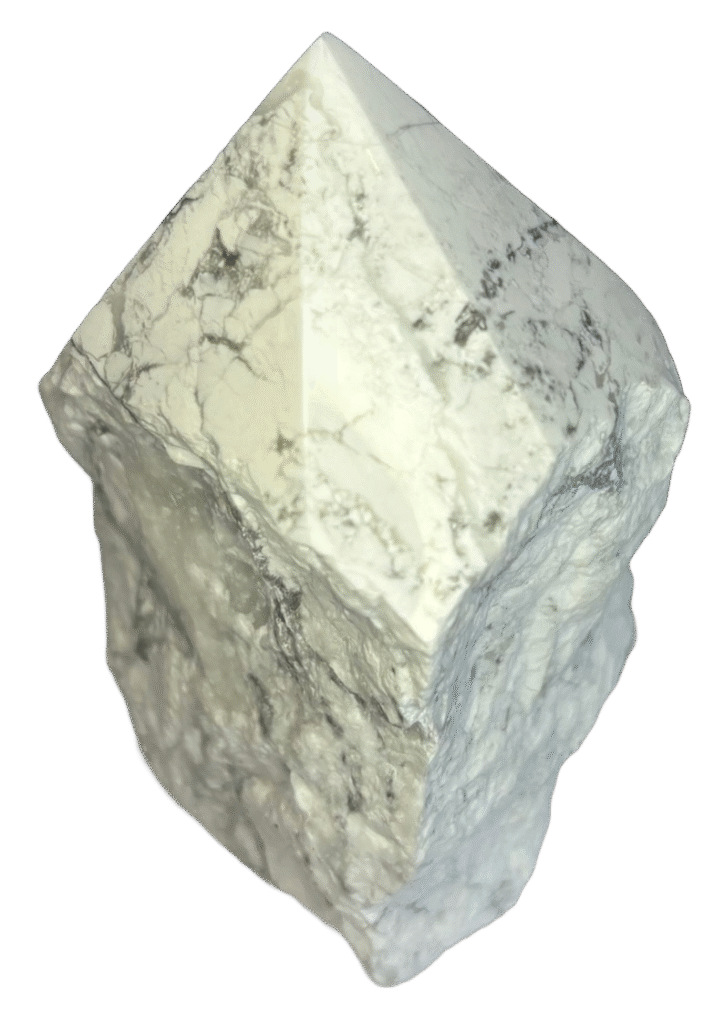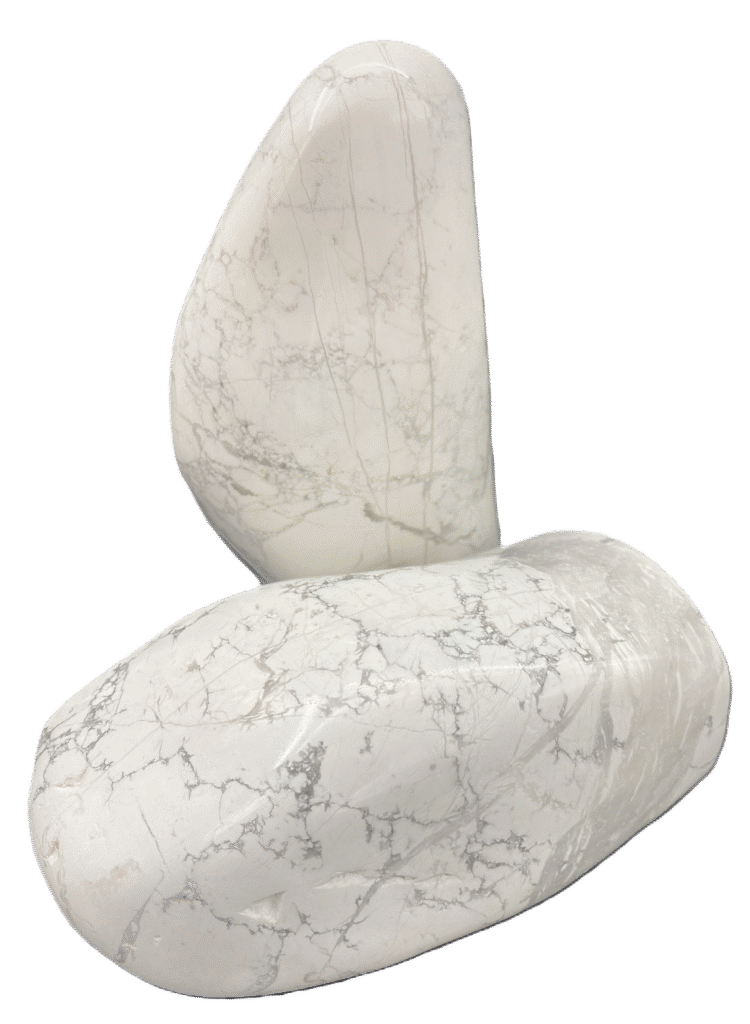
Howlite was first identified in 1868 by Canadian chemist and geologist Henry How, who encountered the mineral in Nova Scotia. Initially referred to as silico-boro-calcite, it was later renamed Howlite by American mineralogist James Dwight Dana in honour of its discoverer.
Alternate names and trade terms include:
- White Turquoise – commonly used when Howlite is dyed to resemble turquoise
- White Buffalo Turquoise or White Buffalo Stone – marketing terms sometimes applied to dyed Howlite, though true white turquoise is a separate mineral
- Turquenite – a name used for dyed Howlite sold as imitation turquoise
Composition, Physical Characteristics and Varieties
Howlite is a calcium borosilicate hydroxide mineral with the chemical formula Ca₂B₅SiO₉(OH)₅. It belongs to the borate mineral group and typically forms in evaporite deposits through the alteration of volcanic ash.
Key physical characteristics:
- Colour: White or greyish-white with black, grey or brown veining
- Texture: Porous, often nodular or cauliflower-like in appearance
- Crystal system: Monoclinic
- Hardness: 3.5 on the Mohs scale
- Lustre: Subvitreous to dull
- Diaphaneity: Translucent to opaque
Varieties include:
- Natural Howlite – white with grey marbling
- Dyed Howlite – commonly blue (to mimic turquoise), red, green or purple
- Chrysocolla Howlite – associated with emotional balance and the heart chakra
- Malachite Howlite – linked to soothing energies and heart-centred healing
Geographical Sources
Howlite is found in several regions across the globe. Notable sources include:
- Canada – Nova Scotia, the site of its original discovery
- United States – particularly California (Tick Canyon) and Nevada (Blue Mountain area)
- Mexico – Cerro Colorado mine
- Turkey – Emet borate mine
- Germany, Russia and China – additional commercial deposits
Historical and Current Usage
Although Howlite was discovered in the 19th century, its calming energy and aesthetic appeal quickly made it popular in both spiritual and decorative contexts. Indigenous cultures used it in ceremonies for emotional healing and spiritual guidance.
Modern applications include:
- Jewellery – beads, cabochons, rings and pendants
- Decorative items – carvings, figurines and home décor
- Dyed imitation – used to replicate turquoise, coral and lapis lazuli
Interesting Facts
- Howlite is often mistaken for turquoise due to its veining and ability to absorb dye
- It is one of the few minerals that can be dyed easily without losing its lustre
- Crystals are rare; most specimens are nodular
- Its lightweight nature makes it ideal for wearable jewellery
- Frequently used in mindfulness and sleep rituals for its calming properties
Folklore, Superstition, Legends and Tales
In folklore, Howlite was carried by warriors to instil peace during conflict. Greek mythology associates it with Selene, goddess of the moon, who calms storms and brings restful sleep.
Native American tribes regarded Howlite as a guardian stone, believed to promote wisdom and protect travellers. It was often used in rituals involving decision-making and spiritual insight.
Mystical Healing Properties and Astrological Links
Howlite is known for its calming and introspective energy. It is believed to:
- Absorb stress, anger and negative energy
- Promote patience, emotional clarity and restful sleep
- Aid in spiritual awareness and higher consciousness
Astrological associations:
- Gemini – enhances communication and mental clarity
- Libra – promotes harmony and emotional balance
- Virgo – eases overthinking and perfectionism
- Taurus – supports emotional resilience
Chakra System Alignment
Howlite primarily resonates with the Crown Chakra (Sahasrara), supporting:
- Spiritual connection
- Mental clarity
- Peaceful meditation
It also benefits:
- Third Eye Chakra – intuition and insight
- Throat Chakra – calm communication and self-expression
Use as a Birthstone and for Wedding Anniversaries
While not a traditional birthstone, Howlite is often associated with Gemini and used in alternative birthstone jewellery.
Anniversary use:
- Featured in modern anniversary gifts for its symbolism of peace and emotional harmony
- Commonly used in matching couple rings, particularly in minimalist or spiritual designs
Crystal Pairings: Compatible and Incompatible Stones
Crystals that complement Howlite:
| Crystal | Benefit |
|---|---|
| Amethyst | Enhances spiritual awareness |
| Clear Quartz | Amplifies Howlite’s calming energy |
| Selenite | Cleanses and recharges Howlite |
| Rose Quartz | Adds emotional healing and compassion |
| Fluorite | Supports mental clarity and intuitive insight |
Crystals to avoid pairing with Howlite:
| Crystal | Reason for Avoidance |
|---|---|
| Carnelian | Its fiery energy may clash with Howlite’s calm |
| Red Jasper | Too stimulating for restful or meditative use |
| Citrine | Energising properties may override Howlite’s soothing effects |

Howlite
Howlite calms a racing mind and softens stress. A white stone of patience, awareness, and emotional clarity—ideal for peace, sleep, and mindful growth.
